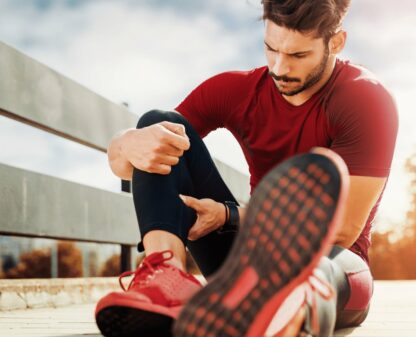Progressing Achilles tendon loads during rehabilitation

Introduction
Achilles tendinopathy is a common running-related injury and may be stubborn to treatment response. The main driver for inadequate progression is underloading during rehabilitation. Progressive loading together with careful pain monitoring are the essential components of Achilles tendinopathy treatment. Yet, the loading impact of a certain exercise is not always clear. This may hamper optimal progression and related improvements in this condition. Therefore, this study investigated the loads on the Achilles tendon in male runners with symptomatic Achilles tendinopathy. Here, we present different exercises for progressing Achilles tendon loads during rehabilitation.
Methods
A cross-sectional observational study was conducted including 24 male recreational runners with symptomatic mid-portion Achilles tendinopathy. This was diagnosed as pain localized 2-6 centimeters above the calcaneus and morning Achilles tendon discomfort. The pain had to be present in this region when performing 10 repetitive single-leg submaximal hops and the symptoms had to be present in the last 6 weeks.
These participants underwent a testing battery consisting of several exercises:
- Double leg heel raise: normal, and slow
- Single leg heel raise: normal, slow, and weighted
- Double leg jumps
- Single-leg forward hops, single-leg hops to fatigue, single-leg hops with minimal contact time
- Skipping
- Walking and running
The exercises are performed according to the table below.

Kinematic and kinetic data were collected to estimate the forces on the Achilles tendon during these 12 commonly prescribed exercises. After each exercise, the pain that was felt was rated on a Numeric rating scale (NRS) from 0-10.
Results
Twenty-four recreational runners with symptomatic Achilles tendinopathy were included. They were on average 45.9 years. They performed the exercises at random, however, the first and last exercise was always walking and hopping to fatigue respectively.
The exercises resulted in the following peak Achilles tendon forces, expressed in body weight. The exercises resulting in approximately 1x body weight were the slow double-leg heel raise and the normal double-leg heel raise. Walking, and the normal, weighted, and slow single-leg heel raise resulted in approximately 2 times the body weight loads on the Achilles tendon.
Hops to fatigue, running and double-leg jumps loaded the Achilles tendon with approximately 5 times body weight loads. The highest Achilles tendon loads were found during skipping, hopping with minimal contact time, and forward hops for distance and resulted in approximately 6 times body weight forces.

The pain was felt the least during the following exercises: walking (NRS approximately 1,5/10), single-leg heel raises and skipping (NRS approximately 2,5/10), double-leg jumps, single-leg heel raise slow and with weights (NRS approximately 3/10).
Hops with minimal contact time and running resulted in somewhat higher pain scores (NRS approximately 4/10). Forward hops for distance resulted in a pain score of approximately 4.5/10 on the numeric rating scale. The most painful exercise in this sample was hopping to fatigue (NRS approximately 5,5/10)

Questions and thoughts
Hopping to fatigue was the most painful exercise, this was found during a pilot test of the study. Therefore, it was always performed last and this may have influenced the pain score. The researchers have tried to avoid cumulative fatigue by letting the participants perform one trial of 10 repetitions of each exercise from which the first and last repetitions were excluded from the analyses.
The current trial found two categories of loads to the Achilles tendon. The first category included the slow double-leg heel raise and the normal double-leg heel raise, walking, and the normal, weighted, and slow single-leg heel raise. On the other hand, hops to fatigue, running and double-leg jumps, skipping, hopping with minimal contact time, and forward hops for distance consisted of the category two exercises.
Between both of the categories, the peak Achilles tendon forces take a giant leap. It increases from approximately 2 times body weight to approximately 5 times body weight. This can be born in mind when progressing Achilles tendon loads during rehabilitation. What was especially interesting was the lack of correlation between the loads on the Achilles tendon and pain.
Talk nerdy to me
Although skipping and double-leg jumps evoked high Achilles tendon loads, they were only at the lower spectrum of pain. These exercises can potentially be used for progressing Achilles tendon loads during rehabilitation, without fearing high levels of pain. Yet, the current research did not find a correlation between levels of pain and loads, suggesting that the difference in pain does not relate to higher loads. Therefore, you can add higher force exercises, which may be more functional, already early in the rehabilitation.
Many protocols adjust exercise progression to symptom levels. This research confirms that in Achilles tendinopathy, this is not always necessary.
Take home messages
Two distinct load categories of Achilles tendon forces exist and are presented here. Loads were the least during walking, double-leg and single-leg heel raises. The results of the current study can be used to select exercises for progressing Achilles tendon loads during the rehabilitation of recreational runners with symptomatic Achilles tendinopathy. Pain was not correlated to loads, and thus the recommendation is to not be overly cautious when prescribing more functional exercises.
Reference
Learn More
Read:
Watch:
WHAT TO LOOK FOR TO PREVENT HAMSTRING, CALF & QUADRICEPS INJURIES
Whether you’re working with high-level or amateur athletes you don’t want to miss these risk factors which could expose them to higher risk of injury. This webinar will enable you to spot those risk factors to work on them during rehab!



